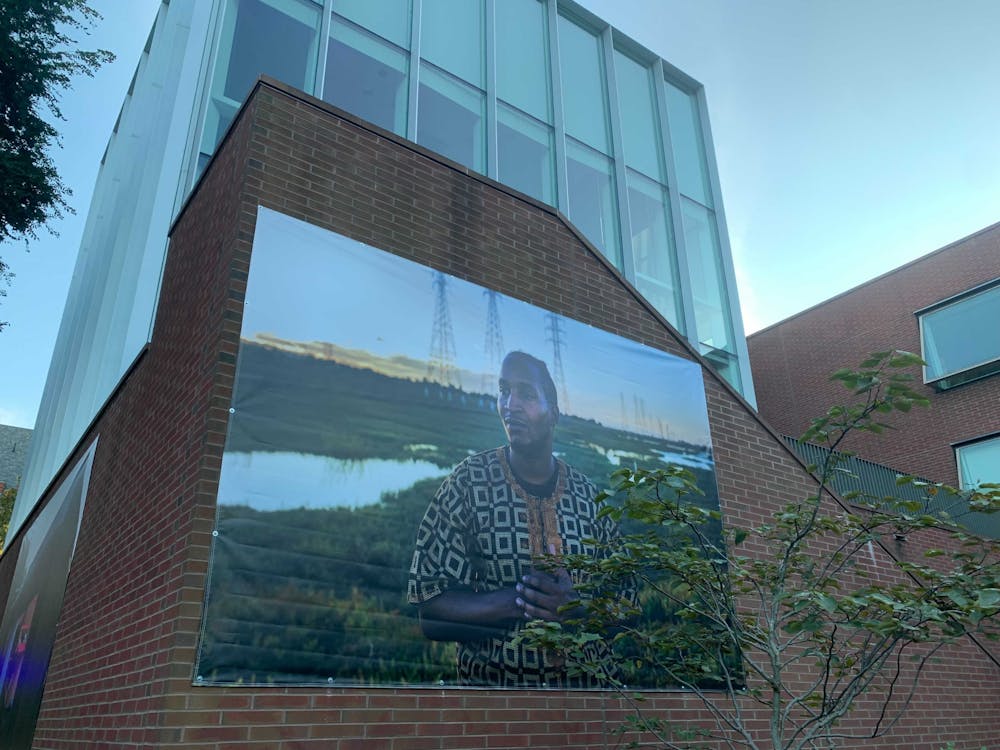The Watson Institute for International and Public Affairs unveiled a new large-scale portraiture series created by Mary Beth Meehan titled “Seeing Silicon Valley” during an Oct. 14 artist talk hosted by Sarah Baldwin, Watson Institute communications specialist. The series is being sponsored by the Watson Institute, the Brown Arts Initiative and the Brown Public Art Working Group, and will remain on campus from Oct. 13 through May 31, 2023.
The series consists of eight large vinyl banners placed along the outer walls of the Watson Institute at 111 Thayer St., depicting workers and residents from Silicon Valley, a region in the San Francisco Bay Area renowned for technological innovation. Meehan’s aim is to illuminate the diversity of Silicon Valley often lost to a homogenous characterization of the area. Additional four-foot prints of other Silicon Valley residents are being placed inside Stephen Robert ’62 Hall at 280 Brook St.
Meehan’s work comes to the University as part of an extensive career in photography, including features in the New York Times, the Washington Post and the Boston Globe, according to the Watson Institute’s website.
The portraits featured in “Seeing Silicon Valley: Life Inside a Fraying America,” a book published in spring 2021 and originally envisioned by Fred Turner ’84, professor of communication at Stanford University. The book was created in collaboration between Meehan and Turner.
As part of her creative process, Meehan rented housing and a car in Silicon Valley and drove around, making conversation with strangers and hearing their stories and relationships with the region. Among the photographs in the series, Meehan depicted a child with developmental disabilities caused by their father’s exposure to lead at work, immigrants who came to the region pursuing careers and social change, an education advocate critical of Silicon Valley’s lack of support for local school systems and more.
Turner, who attended the conversation virtually, has lived in Silicon Valley for over 20 years and has written academically about the region, but felt that the valley he was writing about was a “myth,” characterized by primarily white male inventors who found success as a result of their natural creative genius.
“That wasn’t the world I inhabited at all,” Turner said. “The world I live in out here is radically diverse, radically unequal and just filled with lots of different kinds of people living many different kinds of ways.” Through the book, Turner sought to more critically examine the city and its perception in the American mainstream.
Meehan made her first trip to Silicon Valley in the summer of 2017 when initially looking into an artist-in-residence program at Stanford. Immediately upon coming to Silicon Valley, she found that residents had to navigate issues ranging from market competition and moral dilemmas to loneliness and disconnection from family members. For Meehan, these issues complicate the idealized narrative of Silicon Valley as a paragon of innovation and self-made success.
Turner noted that as an outsider looking into Silicon Valley for the first time, Meehan provided impactful insight into the region’s hustle culture and social norms, pushing Turner to reconsider them.
“The kind of loneliness that Mary Beth made visible is characteristic of an information-driven economy,” Turner said. “One of the deepest fantasies out here (in Silicon Valley) is that we can take the lived world and turn it into information, and that expressing ourselves and building community depends only on being able to turn our voices into digits.”
Turner added that Meehan’s photography “put voices back in the bodies of people who speak them and show how community really lives in bodies.”
“The book is not just about inequality. It’s about unease and it’s about an economy on the ground that could be making life easier for people,” Meehan said. “In fact, it’s making life harder for people.”
Following the event, Meehan told The Herald that “it’s a huge honor to have the work on the walls of the Watson.”
She hopes that sudents will engage critically with the work.
While her series is on display on campus, Meehan hopes “to hear from all your different perspectives ... to learn from all of you.”
“I just couldn’t be happier that we have been able to take (Meehan’s) photographs and make them publicly available,” Baldwin told The Herald.
Baldwin noted she hopes the series can “inspire conversations not just among Brown students but among people walking by.”
Meehan has “brought a very faraway-seeming world to our campus, and the fact that we can share (it) publicly is among the things that excite me most,” Baldwin said.

Jack Walker served as senior editor of multimedia, social media and post- magazine for The Herald’s 132nd Editorial Board. Jack is an archaeology and literary arts concentrator from Thurmont, Maryland who previously covered the Grad School and staff and student labor beats.





